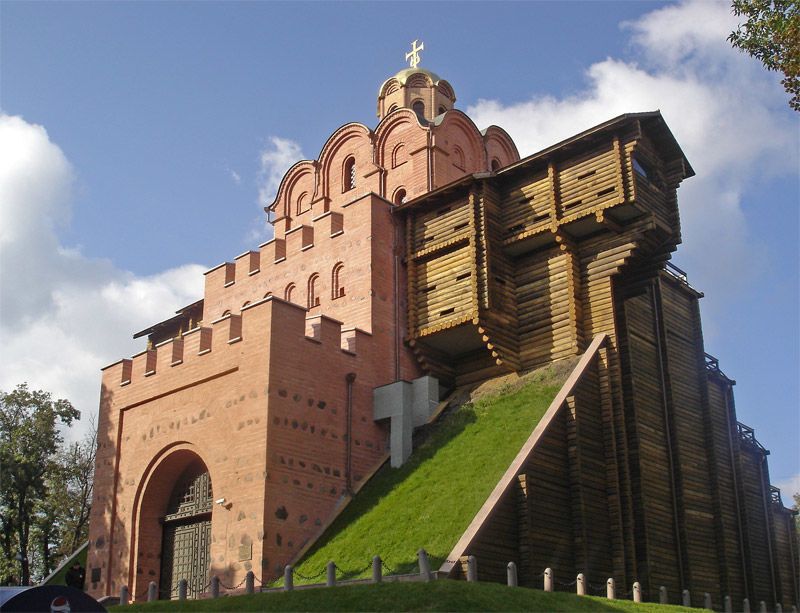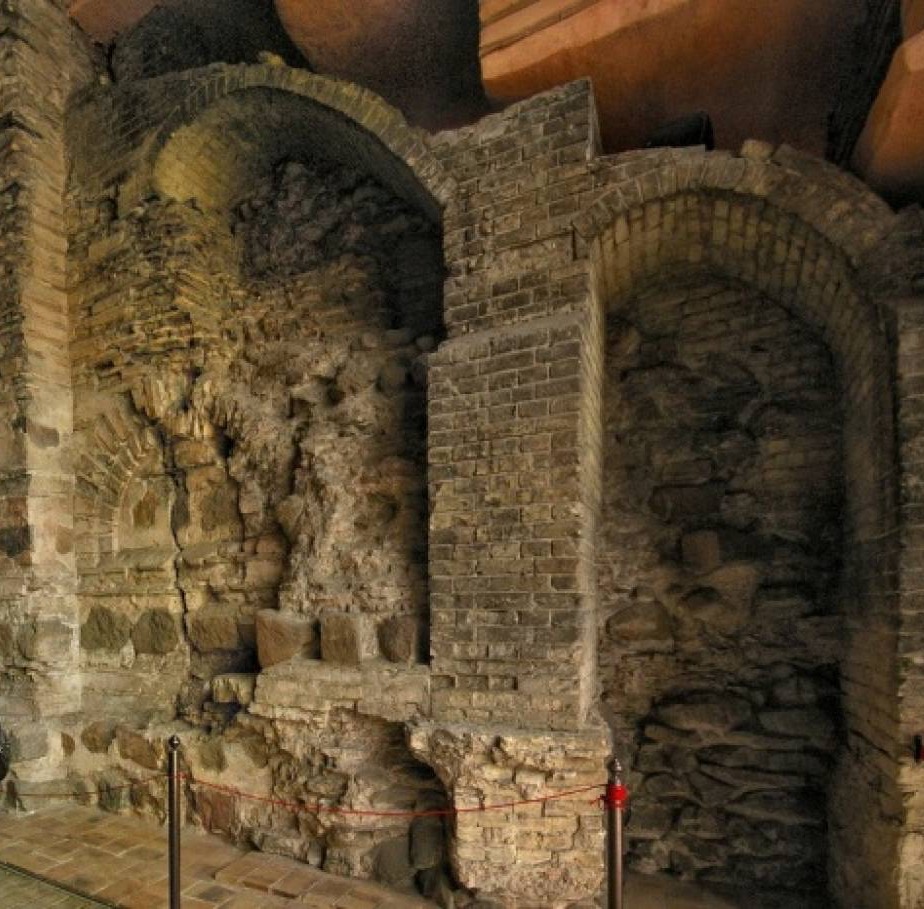 Fortification constructions played a significant role in the life of cities in the early Middle Ages. The constant division of land, the attacks of enemies and the threat of destruction forced the rulers to protect their cities with ramparts, walls and moats. Fortification constructions played a significant role in the life of cities in the early Middle Ages. The constant division of land, the attacks of enemies and the threat of destruction forced the rulers to protect their cities with ramparts, walls and moats.
Kiev of 10th-11th centuries was a magnificent city with huge fortunes, and, therefore, there were a lot of people who wanted to own this pearl of Kyevan Rus. Grand Duke Yaroslav The Wise, during his reign, not only expanded the boundaries of Kiev, but also built a powerful system of protection.
During the constructing of the Golden Gate, the masters used a mixed masonry technique, that is, alternating between different sized bricks of natural stone. The height of the entrance was 12 meters and the width was 6.5. The two-tier tower was completed by the battleground and crowned its Church of the Annunciation of the Virgin. The four-columns temple was decorated with frescoes and mosaics, and the gazebo-covered gilding from the Far East shone in the sun's rays. According to some data recorded in the manuscripts, the facade of the gate adorned the image of the Virgin. The idea of the construction of goblet churches arose at the court of Yaroslav The Wise and became a characteristic feature of the cathedrals of Kievan Rus.
 The city of Yaroslav, located on the Starokyivska (old Kyevan) Hill, was struck by its greatness and was the largest settlement of the time in Europe. The area over 60 hectares was fenced with a shaft 16 meters in height and a width at the base of 30 meters. From the outside, the city protected a huge moat. The fortification, which had a total length of approximately 3.5 km, had three gates, through which it was possible to get to the capital. In the west and east, wooden gates, called Lviv and Lyadsky (polish) were erected. The main entrance to the capital of Kievan Rus struck guests with its power and luxury. The city of Yaroslav, located on the Starokyivska (old Kyevan) Hill, was struck by its greatness and was the largest settlement of the time in Europe. The area over 60 hectares was fenced with a shaft 16 meters in height and a width at the base of 30 meters. From the outside, the city protected a huge moat. The fortification, which had a total length of approximately 3.5 km, had three gates, through which it was possible to get to the capital. In the west and east, wooden gates, called Lviv and Lyadsky (polish) were erected. The main entrance to the capital of Kievan Rus struck guests with its power and luxury.
Golden Gate, a symbol of Kiev and the whole state, got its name by analogy with Constantinople. Consolidated in the period from 1018 to 1024, they performed not only a defensive function, but also embodied the independence and power of the country. "Who own them, will take Kiev" - said the enemies. The beauty and greatness of the Golden Gate made an unforgettable impression. Even the ambassadors of the French king Henry I, who came to engage Anna Yaroslavna, were shocked by this gate.
During the constructing of the Golden Gate, the masters used a mixed masonry technique, that is, alternating between different sized bricks of natural stone. The height of the entrance was 12 meters and the width was 6.5. The two-tier tower was completed by the battleground and crowned its Church of the Annunciation of the Virgin. The four-columns temple was decorated with frescoes and mosaics, and the gazebo-covered gilding from the Far East shone in the sun's rays. According to some data recorded in the manuscripts, the facade of the gate adorned the image of the Virgin. The idea of the construction of goblet churches arose at the court of Yaroslav The Wise and became a characteristic feature of the cathedrals of Kievan Rus.
The beginning of the XIII century became a fatal for Ukrainian lands. Hordes of Mongol-Tatars seized the principality, destroyed cities and villages. Plotting north-eastern lands and the Left Bank, the horde of Khan Batu went to Kiev. Within two months the army stormed the capital and during the fierce fighting it was a weak place. The Wooden Lyadsky Gates did not withstand the onslaught and in November 1240 the Mongols seized Kiev and destroyed it. Since then, there were no mention of the Golden Gate on the history pages.
The first mention of them had place in his diary by a Lviv merchant traveled with a trading caravan around the world. According to his records from 1584, the Golden Gate still served as the main entrance to the city, but was severely ruined.
The main testimonies about the state of Kyiv and in particular the Golden Gate in the middle of the XVII century are the sketches of the Dutch artist Abraham van Vesterfeld. This talented artist was an artist at the court of the Lithuanian hetman Janusz Radziwil and witnessed the liberation war of 1649-1651. Abraham transmitted his impressions and experiences in the form of drawings. Thus, according to copies of his works, the Golden Gate in 1651 still had vaults along the frontier, rescued the arches and remains of the goblet church.
Registered Cossacks, who owned Kyiv from the middle of 1652, began to restore the city's defenses. For the protection from Poles and Turks, the Starokiev Fortress was built. The basis was the remnants of the fortifications of Kievan Rus. In particular, the Golden Gate was reconstructed and the defensive shafts were dumped. On the upper platforms were installed guns.
In spite of all its might and steadfastness, in the middle of the eighteenth century the greatness of the golden gates begins to collapse. Since the gates began to pose a threat to the local population and travelers, in 1750 it was decided to fill them with earth to save them from destruction.
For almost 80 years, the walls of the gates were buried under the earth's thick layer. And from the beginning of the 1920s the archeological study of Kyiv was started. The Golden Gate was one of the top priorities set before the scientists. Under the direction of the archeologist-lover Kondrat Lokhvitsky, two parallel walls of length 25 meters and almost 8 meters high were uncovered from the ground. Contemporaries saw seven pairs of facade pilasters decorating the walls from the inside. The space between the columns was decorated with two-level niches. After a series of reconstruction works, on June 25, 1834, the solemn opening of the monument and its consecration took place.
Over the next decades, regular activities were undertaken to preserve and strengthen the Golden Gate. However, numerous natural phenomena inevitably destroyed the historical monument of ancient greatness of Kievan Rus. Therefore, in 1970, it was decided to protect the ruins by building a protective pavilion over them. The team of restorers, led by Eugenia Lopushinskaya, recreated the original appearance of the Golden Gate.
In 1982, the restoration work was completed and up to the 1500th anniversary of Kiev, the updated Golden Gate was opened. The ruins of the XI century gates became the foundation of the new Golden Gate. Ancient Rus shrine appeared in the form of a jagged tower of 14 meters high crowned by the rebuilt Church of the Annunciation of the Virgin. Speech on the external facade is a "small tower", and the passage is blocked by lifting wooden gates, which are surrounded by metal, on the one hand, and the gate valves according to the ancient pattern - on the other. Thus, the Golden Gate was under the protection of a stone case and remained accessible for contemplation by all those wishing to.
Now in the three-level pavilion of the gate is a museum that tells you the history of the monument and the fortifications of Kiev in general. The decoration of the museum is the ruins of the walls of the Golden Gate, as well as the observation deck and goblet church. Around Zolotovoritsky Square with an old cast iron fountain. He completed the composition of the monument to Yaroslav the Wise, who holds Sophia Kiev in his miniature in the palm of his hand. Unrivaled acoustics allows conducting concerts and dramatic performances in the walls of the museum, as well as exhibitions of ancient Russian themes are an integral part.
Facts:
The Golden Gate is one of the oldest dated buildings in Eastern Europe;
Gained the glory of the impregnable fortress, because there was no mention of invading or capturing the city through them. Even during the Mongol invasion, Khan Batui concentrated an attack on the eastern borders of the capital;
They were part of the defensive structures and defended Kiev for eight centuries;
In 1649, at the Golden Gate, the people welcomed Hetman Bohdan Khmelnytsky after defeating the troops of the Commonwealth.
Kiev & Ukraine Private Tour Guides
|